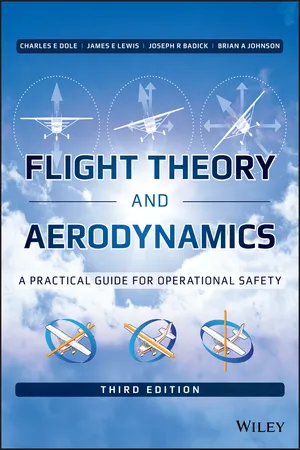
Flight Theory and Aerodynamics
A Practical Guide for Operational Safety
- English
- ePUB (mobile friendly)
- Available on iOS & Android
Flight Theory and Aerodynamics
A Practical Guide for Operational Safety
About this book
Flight Theory and Aerodynamics is the essential pilot's guide to the physics of flight, designed specifically for those with limited engineering experience. From the basics of forces and vectors to craft-specific applications, this book explains the mechanics behind the pilot's everyday operational tasks. The discussion focuses on the concepts themselves, using only enough algebra and trigonometry to illustrate key concepts without getting bogged down in complex calculations, and then delves into the specific applications for jets, propeller crafts, and helicopters. This updated third edition includes new chapters on Flight Environment, Aircraft Structures, and UAS-UAV Flight Theory, with updated craft examples, component photos, and diagrams throughout. FAA-aligned questions and regulatory references help reinforce important concepts, and additional worked problems provide clarification on complex topics.
Modern flight control systems are becoming more complex and more varied between aircrafts, making it essential for pilots to understand the aerodynamics of flight before they ever step into a cockpit. This book provides clear explanations and flight-specific examples of the physics every pilot must know.
- Review the basic physics of flight
- Understand the applications to specific types of aircraft
- Learn why takeoff and landing entail special considerations
- Examine the force concepts behind stability and control
As a pilot, your job is to balance the effects of design, weight, load factors, and gravity during flight maneuvers, stalls, high- or low-speed flight, takeoff and landing, and more. As aircraft grow more complex and the controls become more involved, an intuitive grasp of the physics of flight is your most valuable tool for operational safety. Flight Theory and Aerodynamics is the essential resource every pilot needs for a clear understanding of the forces they control.
Frequently asked questions
- Essential is ideal for learners and professionals who enjoy exploring a wide range of subjects. Access the Essential Library with 800,000+ trusted titles and best-sellers across business, personal growth, and the humanities. Includes unlimited reading time and Standard Read Aloud voice.
- Complete: Perfect for advanced learners and researchers needing full, unrestricted access. Unlock 1.4M+ books across hundreds of subjects, including academic and specialized titles. The Complete Plan also includes advanced features like Premium Read Aloud and Research Assistant.
Please note we cannot support devices running on iOS 13 and Android 7 or earlier. Learn more about using the app.
Information
Chapter 1
Introduction
THE FLIGHT ENVIRONMENT
Table of contents
- Cover
- Title Page
- Copyright
- Table of Contents
- Preface
- About the Authors
- Chapter 1: Introduction
- Chapter 2: Atmosphere, Altitude, and Airspeed Measurement
- Chapter 3: Structures, Airfoils, and Aerodynamic Forces
- Chapter 4: Lift
- Chapter 5: Drag
- Chapter 6: Jet Aircraft Basic Performance
- Chapter 7: Jet Aircraft Applied Performance
- Chapter 8: Propeller Aircraft: Basic Performance
- Chapter 9: Propeller Aircraft: Applied Performance
- Chapter 10: Takeoff Performance
- Chapter 11: Landing Performance
- Chapter 12: Slow‐Speed Flight
- Chapter 13: Maneuvering Performance
- Chapter 14: Longitudinal Stability and Control
- Chapter 15: Directional and Lateral Stability and Control
- Chapter 16: High‐Speed Flight
- Chapter 17: Rotary‐Wing Flight Theory
- Answers to Problems
- References
- Index
- Wiley End User License Agreement